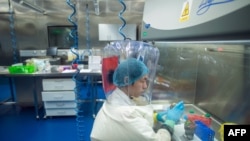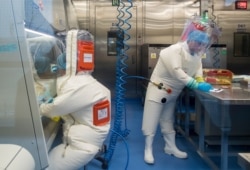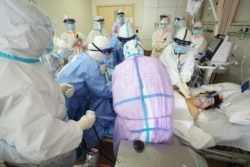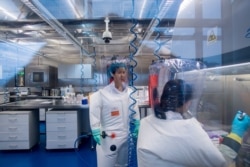In the more than four months since China reported an outbreak of viral pneumonia in Hubei province, the coronavirus has raced to nearly every corner of the world, but there are still no firm answers as to where it all began.
China has said the first infected people caught the virus from live animals being sold in a wet market in Wuhan, Hubei’s main city. But since the first public reports of an unusual viral outbreak emerged last December, many observers have also noted that China’s first Level 4 bio-safety lab, which conducts research on animal coronaviruses, is located just a few kilometers from the wet market.
Is it merely coincidence? Or did the lab play a more substantial role in the outbreak? Without firm evidence, speculation has filled the void. Here’s what we know.
U.S. safety concerns
Nestled in the hilly outskirts of Wuhan, the high-security bio-safety laboratory is Asia's first maximum security lab, housing more than 1,500 virus strains.
It has also been a source of concern for U.S. officials dating back at least two years.
Two State Department cables show that American embassy officials in Beijing made several visits to the research facility and sent two official warnings back to Washington in early 2018 about the lab’s inadequate safety measures. This was at a time when researchers were conducting risky studies on coronaviruses from bats, The Washington Post reported, citing intelligence sources.
Current and former U.S. intelligence officials in recent days also told different news outlets in the U.S. that the intelligence community is examining whether the coronavirus emerged accidentally from the lab and whether "patient zero" worked there.
However, intel sources told VOA that the U.S. intelligence community “has not collectively agreed on any one theory” for the origin of the coronavirus.
While the U.S. investigates, officials say the Chinese government’s continuing lack of transparency, including with respect to the Wuhan Institute of Virology, raises questions over how the outbreak began. Officials also accuse Beijing of still not sharing all of their data with the international community.
Chinese safety concerns
China strongly rejects the possibility that the virus originated in the biosecurity lab instead of from animal-to-human transmission in Wuhan. However, authorities have offered little evidence to back up the claim.
Instead, there is Chinese evidence that the lab had safety problems. VOA has located state media reports showing that there were security incidents flagged by national inspections as well as reported accidents that occurred when workers were trying to catch bats for study.
About a year before the coronavirus outbreak, a security review conducted by a Chinese national team found the lab did not meet national standards in five categories.
The document on the lab's official website said after a rigorous and meticulous review, the team gave a high evaluation of the lab’s overall safety management. "At the same time, the review team also put forward further rectification opinions on the five non-conformities and two observations found during the review."
In addition to problems in the lab, state media also reported that national reviewers found scientists were sloppy when they were handling bats.
One of the researchers working at the Wuhan Center for Disease Control & Prevention described to China's state media that he was once attacked by bats and he ended up getting bat blood on his skin.
In another incident the same researcher forgot to take protective measures, and the urine of a bat dripped “like rain onto the top of his head,” reported China’s Xinhua state news agency.
In China, no single bio-safety enforcer
China’s government has long championed biotechnoloy, but more recently China’s top leader Xi Jinping has made lab safety a higher priority. Xi told a leadership meeting in Beijing last February that the country needed to accelerate the introduction of its first biosecurity law, outlining national policies for handling dangerous pathogens. A draft law was submitted to the Standing Committee of the National People’s Congress, the nation’s top legislative body, for review in October last year.
An independent American review of China’s bio-safety controls in 2016 found that the country had a “shortage of officials, experts, and scientists who specialize in laboratory biosafety.”
Beth Willis, the former Chairwoman of Containment Laboratory Community Advisory Committee, a citizen Lab Advisory Committee based in Maryland, said the greatest danger to the public from labs housing dangerous pathogens are when lab workers unknowingly become infected and then go into the community.
"This actually happened more than once from the USAMRIID (The United States Army Medical Research Institute of Infectious Diseases) labs at Fort Detrick, Maryland. While the worker became ill, or was hospitalized with a deadly pathogen, that pathogen was not infectious person to person, and an outbreak did not occur," she said in an email to VOA.
“Accidents happen on a regular basis. We have seen a few cases of high-profile labs in recent years where accidents happened or mistakes were made. For instance, in 2014 at the CDC (Centers for Disease Control) there were safety lapses involving Ebola virus, anthrax and bird flu, and there have been lapses at the NIH (National Institutes of Health) involving variola virus which causes smallpox," said Dr Filippa Lentzos, a biosecurity expert at King's College London.
“These are just the tips of the iceberg.” Lentzos said.
Chinese investigations into origin of COVID-19
While Chinese diplomats and officials have floated a variety of conspiratorial theories about where the outbreak began, the country’s foreign ministry has insisted the search must be left up to the experts.
"China has mentioned many times that the origin of the virus is a scientific question, which should be evaluated by scientists and medical experts, and should not to be politicized, "Geng Shuang, spokesperson for the Chinese Foreign Ministry, said at a routine press briefing on Monday.
But Chinese officials themselves have produced little data for scientists to examine, and have kept the lab and critical parts of Wuhan virtually sealed off from foreign investigators.
The World Health Organization’s joint report with China published in late February on the virus’ possible origins listed three ongoing investigations into the virus’ origins, none of which appeared to consider the lab as an infection vector.
Virology experts interviewed by VOA believe that researchers should not rule out the possibility that the virus entered the human population due to a laboratory accident.
"A major component of the novel-bat-virus project at Wuhan Institute of Virology involved infection of laboratory animals with novel bat viruses," said Richard H. Ebright, a professor of chemical biology at Rutgers University.
“Therefore, the possibility of a lab accident includes both: (1) scenarios with direct transmission of a bat virus to a lab worker, and (2) scenarios with transmission of a bat virus to a laboratory animal, such as a ferret, and then to a lab worker."
Bio-safety level 4 labs like the one in Wuhan are the most sophisticated containment labs that are designed to work with the world’s deadliest pathogens. However lab design cannot overcome poor training or human error.
This risk is increased if the laboratory is culturing a virus that is readily able to infect humans, particularly via the respiratory tract, as then any droplet caused by simple splash or aerosolization of liquid can be inhaled unknowingly and infect the operator," said Dr. Nikolai Petrovsky, a professor at Flinders University and Research Director in Australia.
"Similarly, if they are wearing gloves that are contaminated and don’t take them off properly this can cause accidental infection. Lastly, if waste material or animal carcasses that are infected are not properly incinerated at high temperature then this could cause contamination including, for example, if the waste is dumped on a garbage pile that is frequented by rats or cats etc.,” Petrovsky said in an email to VOA.
Rutgers University Professor Ebright said in an email to VOA that lab’s previous safety violations indicate it is a possible infection source that should be taken seriously.
"Documentary evidence indicates that the novel-bat-virus projects at Wuhan CDC and Wuhan Institute of Virology used PPE and bio-safety standards that would pose high risk of infection of lab staff upon contact with a virus having the transmission properties of the outbreak virus," Ebright said.
VOA's correspondents Jeff Seldin and Nike Ching contributed to this story.















